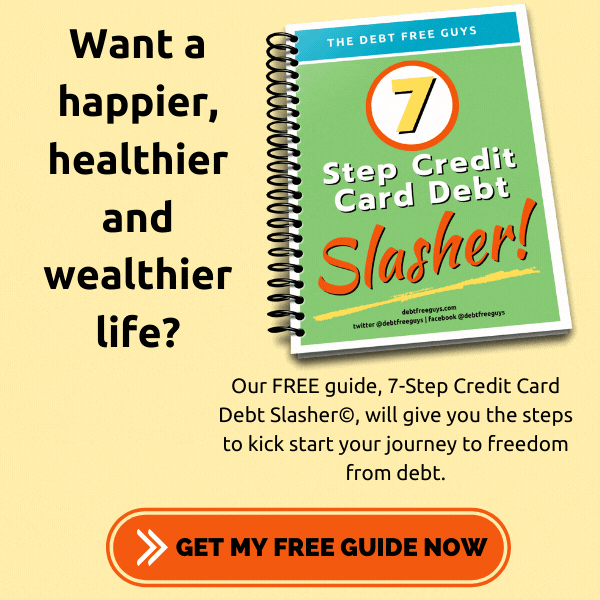Psst! The Debt Lasso Method is the best way to pay off credit card debt
You’ve heard of the Debt Avalanche and Debt Snowball methods for tackling credit card debt, but what if there’s a better way? Introducing the Debt Lasso Method—your ultimate solution for regaining financial freedom. Start lassoing your debt easily with a free copy of the 7-Step Credit Card Debt Slasher here.
What are the three primary credit card pay off methods?
Debt Snowball Method
The Debt Snowball method is like tackling your debt with a snowball fight strategy: make minimum payments on all your cards, then throw any extra cash at the card with the smallest balance. Once that card is knocked out, take its payment and roll it over to the next smallest balance, and so on. Before you know it, you’ll have an avalanche of payments knocking out your debt one snowball at a time.
Debt Avalanche Method
The Debt Avalanche method is like playing whack-a-mole with your interest rates: keep making minimum payments on all your cards, but use any extra cash to hammer down the card with the highest interest rate first. Once you’ve knocked out that pesky high-interest card, move on to the next one and keep smashing those interest rates until they’re all flattened.
The Debt Lasso Method
The Debt Lasso method may sound like a refinancing rodeo, but it’s more than that. This method lassos your credit cards by making minimum monthly payments while rounding up those balances into lower (hopefully zero-interest) credit cards or personal loans. Once you’ve roped in those lower rates, automate your payments and channel any extra funds toward the card with the highest interest rate. Yeehaw!
Time to wrangle that debt.
How to pay off credit card debt using the Debt Snowball Method
What’s the Debt Snowball Method?
The Debt Snowball Method, championed by—hold your nose—Dave Ramsey, who’s as passionate about debt-free living as a kid in a candy store—is all about small victories. He suggests tackling your credit card debt by paying off the smallest balances first while making minimum payments on the rest. Once you’ve conquered the smallest debt, move on to the next smallest and keep going until all your cards are history.
This method offers instant psychological wins, like a series of high-fives from your bank account, even though it might take longer and cost more in the end.
The Debt Snowball Method step-by-step
Here are the steps for the Debt Snowball Method:
- List all your credit card balances on a spreadsheet, including their current balances and minimum payment information.
- Sort this list by current balance.
- Total the column with the minimum payment information.
- Determine an amount larger than the minimum payment you’re willing to commit to making every month—every single month.
1. Subtract the total minimum payment from the total from step #4. This is your monthly bonus payment amount. - Pay the minimum amount for all your cards except those with the smallest balance.
- Add and pay the bonus payment amount from step #5 to the minimum payment amount for your card with the smallest balance.
- Repeat steps 1-7 every month until your card with the smallest balance is paid off. Every. Single. Month.
- Start using your credit cards with balances, including the growing bonus amount on your card with the smallest balance. As each credit card is paid off, this bonus amount should grow, allowing you to make more significant payments on each remaining card.
Why the Debt Snowball Method isn’t the best credit card pay off method
The Debt Snowball Method has its quirks and risks.
First, it might cost you more than other methods because you’ll hang onto those high-interest balances like they’re going out of style. Plus, it’s the slowest way to pay off your credit cards since you focus on the smallest debts rather than the most expensive ones.
And let’s be honest, those quick wins can lose their sparkle. Since this method takes the longest, you risk your initial motivation melting away faster than a snowball in summer.
Watch us share the Debt Lasso Method with Rachael Ray:
How to pay off credit card debt using the Debt Avalanche Method
What’s the Debt Avalanche Method?
The Debt Avalanche Method is about taking down your highest interest rate credit card first while making minimum payments on the rest. Once the top dog is paid off, move on to the next highest rate and continue until all your debt is history.
This makes sense. Prioritizing the most expensive debt should save you money on interest and reduce repayment time compared to the Snowball method.
But here’s the catch: the Debt Avalanche Method lacks the charisma of the Snowball Method’s quick wins, takes longer, and costs more than the Debt Lasso Method. It’s like eating your most miniature favorite vegetables first—logical but not exactly fun.
The Debt Avalanche Method step-by-step
Here are the steps for the Debt Avalanche Method:
- 1. List all your credit cards on a spreadsheet, including their current balances, minimum payment information, and current interest rate or APR% from your monthly credit card statements.
- Sort the list based on the current interest rate or APR.
- Total the column with the minimum payment information.
- Determine an amount larger than the minimum payment amount that you’re willing to commit to paying every month—every single month.
- Subtract the total minimum payment from the total from step #4. This is your monthly bonus payment amount.
- Pay the minimum amount for all your cards except those with the highest interest rate.
- Add and pay the bonus payment amount from step #5 to the minimum payment for your credit card with the highest interest rate.
- Repeat steps 1-7 every month until your card with the highest interest rate is paid off. Every. Single Month.
- Start the process again using credit cards with balances, including the growing bonus amount for your card with the next highest interest rate. With each credit card paid off, this bonus amount should grow, allowing you to make bigger payments to each remaining card.
Why the Debt Avalanche Method isn’t the best credit card pay off method
The Debt Avalanche Method is like the tortoise in the race against the Debt Snowball’s hare—it might be slow and steady, but it’s faster and saves more money in the long run.
However, both methods miss out on the golden opportunities that the Debt Lasso Method provides. So, while the Avalanche might have logic on its side, it lacks the lasso’s flair for roping in savings and speed.

With the Debt Snowball and Debt Avalanche methods, you’re not minimizing the biggest roadblock to becoming debt-free: those pesky credit card interest rates. Plus, juggling payments on multiple cards and crunching the numbers each month can feel like a math class you didn’t sign up for, increasing the risk of missing or forgetting payments.
Enter the Debt Lasso Method, riding in to simplify your debt wrangling with flair and efficiency.
What’s the best method for paying off credit card debt? It’s the Debt Lasso Method
Simply put, the Debt Lasso Method is the best way to pay off credit cards. Here’s why:
- It’s the fastest way to pay off credit card debt
- It’s the cheapest way to pay off credit card debt
- If done based on the steps outlined below, it’ll improve your credit score
- The payment process can be automated, reducing your need to redo calculations month-to-month like the Debt Snowball and Debt Avalanche require
- It combines the best of both the Debt Snowball and Debt Avalanche methods
How to pay off credit card debt using the Debt Lasso Method
Here are the steps for the Debt Lasso Method:
Note, to get the most value from this method, you must commit to not using these or any of your credit cards anymore.
- Get the Simple Spending Analysis in the Credit Card Debt Slasher Toolbox.
- List all your credit cards on a spreadsheet, including their current balances, minimum payment information, and current interest rate or APR% from your monthly credit card statements.
- Total the column with the minimum payment information.
- Determine an amount more extensive than the minimum amount you’re willing to pay every month – Every. Single. Month. Then, add this total to the Committed Monthly Payment field on the Beginning Payment Calculator in the Credit Card Debt Slasher Toolbox.
- Subtract the total minimum payment amount from the total from step #3. This is your bonus payment amount each month.
- Add the bonus payment amount from step #4 to the minimum payment amount for your card with the highest interest rate.
- Set up auto-pay from your bank for the minimum required payment for each card, plus the bonus payment from step #5 to your card with the highest interest rate.
- Shop and apply for 0%-interest balance transfer credit cards and low-interest loan offers.
- Determine which credit card(s) to transfer to the new 0%-interest balance transfer credit cards and loans you’re approved for.
- You can transfer your balances to the new credit card(s) or pay them off with the low-interest loan(s).
- If you’re using a 0%-interest balance transfer credit card offer, set a calendar reminder for 2 months before the offer ends to start shopping for a new 0%-interest balance transfer credit card or loan if your balance won’t be paid off before when the offer ends.
- Repeat steps 1-6 for your new credit cards and loans.
- Once a balance is paid off or you apply for and receive a new transfer offer, start the process again using your credit cards with remaining balances, including adding the new bonus amount to the card with the next highest interest rate. With each balance paid off, this bonus amount should grow, allowing you to make bigger payments to each remaining balance.
In order for any method, especially the Debt Lasso Method, to work, you must commit to not reducing your monthly payments based on your new, lower required minimum monthly payments. Doing so lets you focus all of your payments on paying off your principal balance rather than your credit card interest.
The odd contradiction of the Debt Lasso Method
Let’s talk about the quirky twist in the Debt Lasso Method so you don’t freak out when you hear the steps. Yes, you’ll get more credit with the Debt Lasso Method, which sounds like a bad idea at first. But trust us, it’ll speed up your payoff process.
And no, we’re not robbing Peter to pay Paul. We’re just giving Peter a much better interest rate.
How the Debt Lasso Method works
In the wild world of debt-busting strategies, the Debt Lasso method aims straight for the jugular: your interest rate. Wrangling the lowest possible rate, ideally 0%, can turbocharge your credit card payments faster than a caffeinated cowboy.
For those flaunting stellar credit scores, lassoing a balance transfer credit card with a 0% rate is like finding gold in them thar hills. Just beware of the 1-5% transfer fee—it’s the sneaky sidewinder in your debt-reducing rodeo. And for those with less-than-perfect scores, consider roping in a low-interest loan from a trustworthy bank or credit union instead.
7 myths about credit and credit cards
1. Is the Debt Lasso Method just credit card consolidation?
No, it’s a comprehensive plan that uses four other steps besides credit card consolidation. Those steps are:
- Commit
- Trim
- Lasso
- Automate
- Monitor
2. Close your credit cards when they are paid off vs. never closing your credit cards
The truth is, when it comes to managing credit cards, there’s no one-size-fits-all approach that’s 100% right or wrong.
With the Debt Snowball and Debt Avalanche methods, closing a credit card account can throw a wrench into your credit utilization ratio—basically, how much credit you’re using versus how much you have available. High utilization (over 35-40%) can bruise your credit score, about 30% of your FICO score. Enter the Debt Lasso method: you’re not just keeping cards open. You’re even opening new lines of credit to lasso that debt faster, which can lower your utilization and boost your score.
But hold your horses—having too many open cards can make lenders squirm, fearing you’ll go on a spending spree. So, strategically shut down those retail cards for stores you haven’t graced in ages or any temptation-trap cards. They won’t help with your Debt Lasso anyway. And don’t forget the golden rule: keep the oldest card open like it’s the last slice of pizza.
Once you’ve tamed your debt beast, close accounts slowly to unwind that access to too much credit. Since your new accounts from the Debt Lasso method are fresh, they don’t have much credit history (about 15% of your FICO score), so consider trimming the fat cautiously. Start with the sketchy cards first—like those retail accounts—and watch your credit score wrangle into shape.
3. Credit card debt is a way of life, and everyone has it
According to a CNBC survey, about 55% of U.S. adults with credit cards carry balances month-to-month. Nearly half of us are credit card debt-free and cruising along just fine without them.
Think of credit cards like swimming in the deep end of personal finance. Once you’ve mastered the stroke (paying off your cards monthly), there are some real perks to diving in. For starters, cashback rewards cards can shave off 1-8% of your spending—talk about saving some dough!
Now, travel rewards cards? They’ve lured many into the credit card debt abyss. But once you’ve cracked the financial code and used them wisely, they can unlock a world of adventure. Our favorite took us gallivanting through Ireland, England, Spain, Australia, New Zealand, and the good ol’ USA—talk about jet-setting with style.
4. Negative items on your credit report are removed when you pay off your debt
Oh, wouldn’t it be nice if all our past financial blunders could vanish with a wave of a wand?
Unfortunately, it’s not that pretty magical. If you’ve wrestled with discharged debts, write-offs, or collections you’ve since squared away, they can linger on your credit report for up to seven years. To check if these ghosts still haunt your credit, summon your free credit report from freecreditreport.com.
But fear not! The Debt Lasso method comes with a silver lining. It thickens up your credit file—yes, that’s an actual term in finance. A thin file means you’ve got scant credit lines. By roping in new cards through the Debt Lasso approach, you beef up the number of accounts and payment history on your report. This added info can help overshadow past slip-ups and make them less glaring. It’s like adding extra layers to your financial resume.

A word of caution; the more information added to your credit file, the more the opportunity for mistakes. About 5% of credit accounts have mistakes, so review your info at least annually.
5. Don’t use credit cards to have the best credit score
This isn’t quite how it works. If it were that easy, we’d all start with a perfect credit score straight out of the gate.
Your credit score is a mix of factors, and one biggie is your credit history—how long you’ve been at this credit game and whether you’ve been making those payments. If you’ve got a sparse credit history or big gaps, lenders might see you as a bit of a wild card and ding your score accordingly.
Oops-a-daisy!
The road to a better credit score is paved with proving you can handle credit like a boss, which means having cards and paying them off like clockwork each month.
As mentioned in points one and three (or two and four?), having more in your credit history is like beefing up your credit dossier. With the Debt Lasso method, you’re adding to that history and variety of credit info, which can help boost your credit score faster than a rocket-powered unicorn.
6. A low credit score means you can’t get credit
Someone’s always willing to lend you a hand—or rather, money—but it’ll cost you a pretty penny.
A low credit score paints you as a bit of a daredevil in the world of credit. The riskier you seem, the more lenders will slap on interest rates that could make a Wall Street banker blush. They might even hold back on how much they let you borrow in the first place.
But fear not! You can flip the script and show those skeptical lenders what you’re made of. Regularly paying off what you borrow is vital, and that’s exactly what the Debt Lasso method aims to do. You might not snag the best rates right off the bat, but as you prove you can handle more credit and pay off those balances, you’ll flip their script faster than a pancake at a breakfast buffet. Your credit score could go from zero to hero in a few months to a year, especially if you’re wiping those balances clean every month.
7. Having multiple credit cards is bad for your credit score
Credit cards aren’t looking for a monogamous relationship. It’s all about spreading the love around.
The myth that having multiple cards is lousy news stems from those who couldn’t quite juggle them all—a credit score crusher if there ever was one.
Now, I’m not suggesting you become a credit card Casanova, but having more than one card can show lenders you’re a credit-savvy player—as long as you’re playing your cards right (pun intended). With our Debt Lasso method, we beefed up our card count, and wouldn’t you know it, our scores got a boost. We even have folks in our Credit Card Pay Off Plan rocking over 10 cards while still wrangling their debt—and it’s working wonders for their credit scores, not setting them back.
Balance transfer credit cards — what are they and how do you find one?
What’s a balance transfer?
A credit card balance transfer is like a mid-game trade in the credit card league. It’s when your current team offers you a deal or you scout out a free agent with better rates and move your money over to their squad.
In simpler terms, a balance transfer means shifting some or all of your credit card debt from one card to another, which offers a sweeter interest rate deal. Of course, there’s usually a transfer fee involved—typically between 1% and 5% of the amount you’re moving over. It’s like paying a trade fee to switch jerseys in the financial playoffs.

With most transfers, there’s a temporary offer period when the introductory interest rate is lower. This rate will often become significantly higher after the offer introductory period ends or if you miss or are late on a payment—even one payment.
We’ve seen increases as high as 31%. Ouch!
What’s a balance transfer credit card?
When considering using balance transfer credit cards, three factors must be considered: the balance transfer fee, the introductory interest rate, and the time frame for the introductory rate.
What’s credit card refinancing?
Credit card refinancing is similar to a balance transfer, but you combine the balance of two or more credit cards into one. You’re using one credit card to pay off the balance of the others. Usually, you do this to take advantage of a better fee structure to pay off the balance before the fee structure changes.
What’s credit card refinancing vs. debt consolidation?
When it comes to credit card refinancing, it’s like playing musical chairs with your debt. You’re using one card to shuffle around and pay off others, hoping for a better seat (or interest rate) each time. It’s a bit like stretching out the game of paying off debt—kind of like kicking that can down the road, but not exactly optimal.
Now, debt consolidation? That’s like calling a timeout and getting a game plan together. You snag a personal loan from a bank or credit union to wipe out multiple credit card debts. It locks you into a set interest rate and payment schedule, which can be a slam dunk—if you can resist the urge to charge up those cards again. It’s all about committing to the payoff game plan without getting sidelined by those enticing $0 balances on your plastic friends.
What are balance transfer and no-fee credit cards?
Finding a balance transfer credit card with a low introductory interest rate and no balance transfer fee is like finding a unicorn in a haystack—not impossible, but pretty darn rare. These cards make money by luring you in with that sweet low or 0% introductory rate, then hitting you with a transfer fee.
Balance transfer fees typically range from 1% to 5%. So, if you’re moving a hefty $12,000 to a new card with a 3% transfer fee, you’re looking at a $360 fee. That’s like paying a cover charge to switch dance floors in a financial nightclub. This fee gets tacked onto your new card’s balance, and you’ll make payments with the amount you transferred.
Remember, most balance transfer cards have rules of their own—they might limit you to transferring a percentage of your credit limit or calculate the maximum amount you can transfer plus the fee without busting your credit limit. It’s like playing a game of financial Tetris to fit within their rules and still score those savings.
What is the 0% interest rate on balance transfer credit cards?
Balance transfer credit cards, especially those elusive 0% interest rate ones, turn the Debt Lasso Method into the Usain Bolt of debt payoff strategies. These cards typically come with a sweet introductory period—usually between 12 to 18 months—where you can kick back and watch your debt shrink without paying a cent in interest.
Picture this: You snag a 0% balance transfer card with a generous $12,000 limit for 18 months. You move over $11,650 and cough up a 3% transfer fee, adding about $349.50 to your balance. But hey, you’ve got 18 months to chip away at that $12,000 debt mountain without interest piling on. Watch out for any annual fees lurking in the fine print—those sneaky critters can rain on your debt-free parade.
Oh, and a friendly heads-up: don’t snooze on the sofa when your introductory period sunsets. Some cards jack up their interest rates faster than a kid on a sugar rush. Set a reminder to scout for a new card a few months before the intro ends if you need more time to polish off that balance.
What’s the best balance transfer credit card?
Finding the best balance transfer card is like finding the perfect mate—everyone’s situation is unique, and not every card is a match made in financial heaven. If you’ve got a stellar credit score, you might snag a 0% interest dreamboat for 18 months without breaking a sweat. But if you’ve got a towering debt spread across multiple cards, finding a single card willing to corral all that debt can feel like herding cats. And if your credit score’s taken a few hits, getting that 0% offer might seem as likely as finding a unicorn in rush hour traffic.
But fear not! There’s a card out there for everyone—it just might take a bit of hunting. We’re here to lend a hand, so if you have questions or need guidance, hit that Contact link at the top of the page and send ’em our way. We’ve got your back on this quest for financial bliss.
Watch us explain the Debt Lasso Method to Good Morning America (please excuse David’s COVID hair):
Need more help with your debt?
Read the full article here


















